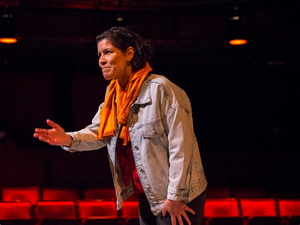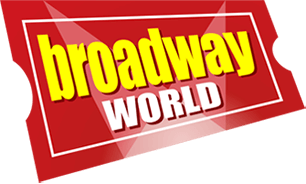Review: FIRES IN THE MIRROR at Baltimore Center Stage: Really Listening To All Sides After A City Explodes
 Press night for Fires in the Mirror happened to coincide with the annual holiday illumination of the Washington Monument, that is, a monument to one of our founding enslavers, just up the hill from it. These events transpired just blocks away from Madison Street, named after another founding enslaver. And I defy anyone to say definitively how to think about either of these men. They each exemplified the best and the worst of us, all at once. I thought about this as I was taking in Fires in the Mirror, Anna Deavere Smith's now-classic theatre piece about the Crown Heights, Brooklyn disturbances of 1991, the singular point of which is that it's impossible to know exactly what to think about those events either.
Press night for Fires in the Mirror happened to coincide with the annual holiday illumination of the Washington Monument, that is, a monument to one of our founding enslavers, just up the hill from it. These events transpired just blocks away from Madison Street, named after another founding enslaver. And I defy anyone to say definitively how to think about either of these men. They each exemplified the best and the worst of us, all at once. I thought about this as I was taking in Fires in the Mirror, Anna Deavere Smith's now-classic theatre piece about the Crown Heights, Brooklyn disturbances of 1991, the singular point of which is that it's impossible to know exactly what to think about those events either.
As to those events, there were two deaths involved. First, a Black immigrant child named Gavin Cato was run over and killed by a car driven in a motorcade accompanying a Lubavitcher Jewish rabbi, which had speeded up to avoid a red light, hit another vehicle, and then bounded up onto the sidewalk, where young Mr. Cato was repairing his bike. Second, Yankel Rosenbaum, a visiting Australian grad student, was set upon and violently killed by a crowd of young Black men inflamed by the death of Mr. Cato. And after that, riots broke out, with the accompanying large police presence, destruction of property, injuries, arrests, demonstrations, and involvement of public personalities like the Rev. Al Sharpton.
Not long after the riots, playwright Smith came to interview community members and participants, and assembled a collage of interview excerpts in which she reenacted each interviewee's words. What she found and her theatre piece recounts, is that there were two of everything. There were two communities, Jewish and Black, and each had its own fiercely-maintained identity that contributed to the development of not only a perception of the meaning of the events of August 1991, but even of the underlying facts.
For instance, take the matter of medical intervention. When Mr. Cato was lying under the car, did a Jewish community ambulance crew present on the scene fail to render assistance because official NYFD ambulances were already there and fully taking charge, or were the Jewish volunteers just uninterested in helping anyone but Jews? Did Mr. Rosenbaum die in the hospital because someone overlooked a stab wound or was something more sinister than neglect in play? Was the person charged with inflicting that stab wound not the kind of young man to act that way? Was the Jewish community open to and engaged with the Black community around it, or was it closed off and resentful? Was the Black community rife with anti-Semitism? To the extent the histories of the two communities, both with justified cause for grievance, played a role, whose grievances were greater? We hear both sides of all these issues.
More than both, actually. Smith's documentary style also gives voice to many gradations of opinion, many shades of grey. For instance, early in the show we hear from a Lubavitcher housewife recounting how she managed to ask a young Black boy indirectly (a direct request would have been forbidden by her faith) for help turning down a loud radio on the Sabbath; the resulting picture is not of two communities wrapped in each other's embrace, but certainly not of communities always poles apart either. Later, we hear from a member of the Black community about the diminishing closeness of the Lubavitchers to others, supposedly prompted by a mortal threat from another Orthodox community, the Satmars, a threat the speaker thinks had led the Lubavitcher rabbi to speed through the streets under police escort, leading to the accident. But that diminished state of affairs implies a time when the communities were closer.
Heightening the overall unresolved effect is Deavere's way of reproducing the words of the speakers she chronicles, complete with all of the sorts of things that typically make speech harder to comprehend: false starts, circumlocutions, losing the point, private allusions, etc. All of this operates as a fog machine around the speakers' true meanings and actual thoughts, and especially around the events being recounted. For instance a presumably Black schoolgirl is quoted criticizing some unspecified group of fellow-students, presumably Latinx:
"In my class you can't call any of them Puerto Ricans. They despise Puerto Ricans, I don't know why. They think that Puerto Ricans are stuck up and everything. They say, Oh my Gosh my nail broke, look at that cute guy and everything. But they act like that themselves. They act just like White girls. Black girls is not like that."
Or Leonard Jeffries, then a CUNY professor of African Studies, on what appears to have been an effort to ostracize him:
"But I knew what was at stake ever since they branded me a conspiracy theorist, February 12, 1990, two-column editorial in the New York Times. That was, in the concept of Jewish thinking, the kiss of death. I knew I had been targeted. Arthur Schlesinger went and wrote a book called The Disuniting of America. He has everybody in the margin except a half-page photo of myself which said to us, 'This is the one they got to kill.' We knew that Schlesinger and his people had sent out a thousand letters to CEOs around the country and foundation heads not to have anything to do with all of us involved in these studies for multicultural curriculum..."
We can sort of get the idea being expressed in each speech, but all kinds of important information has to be inferred, and on the fly, because all of this talk is hurtling by. Hearing it is an experience more than a real exposure to facts or ideas.
You can call this Smith's flaw or her genius, and both comments would probably be true. She, who was the original performer of the piece, and the performers who have followed in her footsteps, immerse us in the experience of encountering 26 characters in all via dazzling impersonations that certainly bring them to life, but do not trouble to provide anything like full explanations of who they are or what they mean by what they say.
Take Leonard Jeffries' cryptic remarks already quoted. We can't turn on our devices in the theater, so we can't on the spot look up the February 12, 1990 New York Times, or form any judgment why anyone would brand Jeffries a conspiracy theorist on the basis of it. From my own subsequent research, it seems likely Jeffries was talking about a piece about him that actually ran in the Times on August 6, 1991 reporting on his remarks the previous month which ultimately led to his being terminated from his academic post. From the reporting, it would seem his remarks on that occasion had indeed been virulently and unambiguously anti-Semitic, and were in fact redolent of conspiracy theory. Demonizing the perfectly proper reaction against him, as he does in Fires, is Demagoguery 101 stuff. But it should be noted as well that historically there were certain Jews involved in the slave trade, just as Jeffries was alleging in the reported remarks. (The failure to mention that involvement in the current Broadway hit The Lehman Trilogy is part of the controversy currently surrounding that play.) In other words, by bringing this controversial figure into Fires, Smith is continuing the play's pattern of highlighting the moral ambiguity on both sides.
But on a big picture level, we here in Baltimore have good reason to know that the grievances on all sides remain, and that the eruptions of violence sometimes return. Ultimately, if the show proposes any solutions to this cycle of fratricide, it seems to reside in the importance of listening to each other, of taking honest measure of each other, just as the show itself does. No one's point of view should be dismissed without a hearing.
On press night the performer was Khanisha Foster (alternating with Cloteal L. Horne). Obviously, I can only speak of Foster. She is breathtakingly good. Every character she embodied, whatever the accent, age, race or gender, comes across as real and distinct. Two choices were made surrounding her performance; one I liked, one I'm not so sure about. The first was that at the outset she introduced herself and discussed her own biracial background, which likely informed and deepened her multiple characterizations. It was good information to have. The other choice was that at the end she led the audience in a breathing and chanting ritual focused on strengthening our resolve to bring about a better world. Let's just say it wasn't automatically very moving.
This production, produced in partnership with Connecticut's Long Wharf Theatre, marks the continuing evolution of Baltimore Center Stage under Artistic Director Stephanie Ybarra's guidance, and was consistent with her stated goals of emphasizing new stories and new storytellers. There also seems to be a tendency to pursue co-productions and to further nationalize our regional theater. It is certainly interesting to watch.
Fires in the Mirror: Crown Heights, Brooklyn and Other Identities, by Anna Deavere Smith, directed by Nicole Brewer, presented by Baltimore Center Stage, 700 N. Calvert Street, Baltimore, MD 21202, through December 19, 2021. Tickets $20-$74, at www.centerstage.org and 410.332.0033. Contains strong language, references to racism, slavery, lynching, anti-Semitism, sexual violence, and the Holocaust.
Pictured above: Khanisha Foster.
Photo Credit: J Fannon.
Comments
Videos

